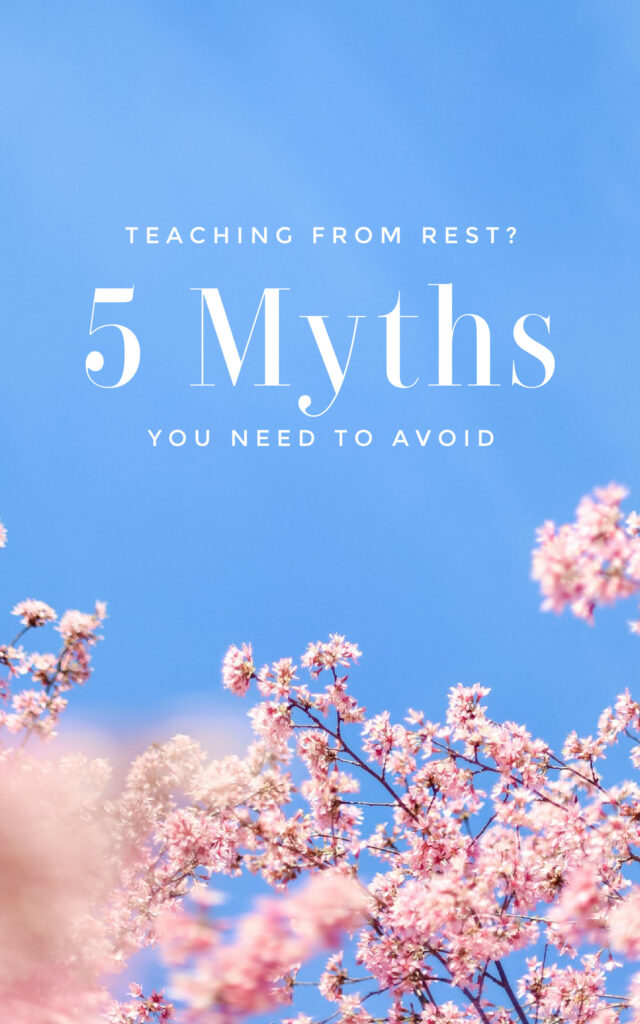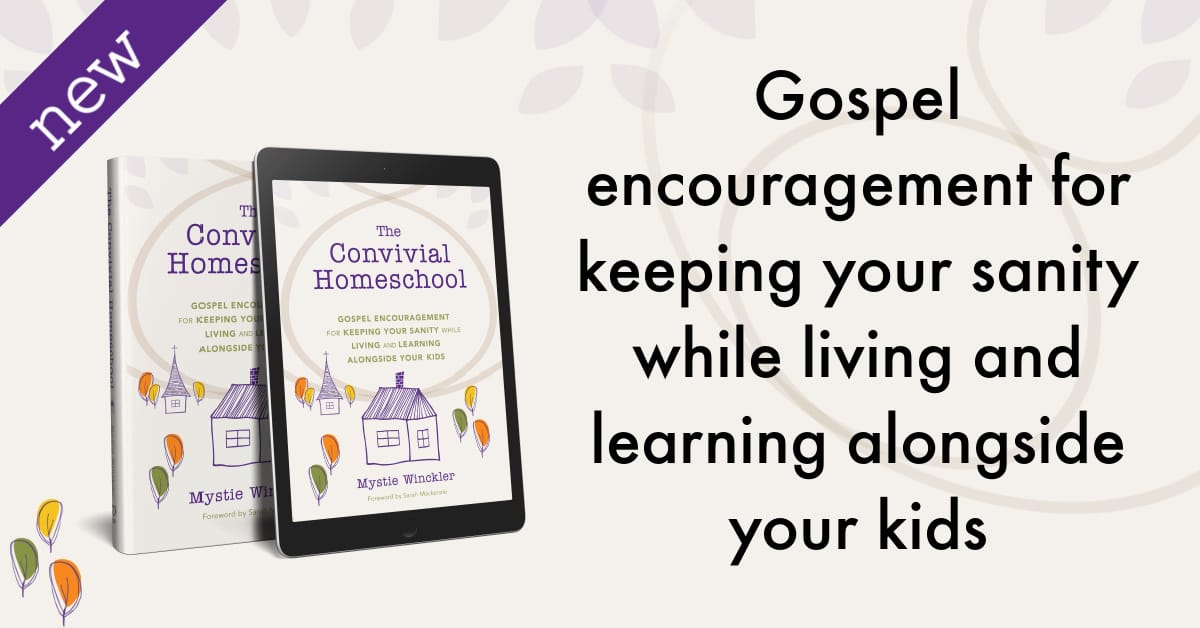
5 Myths about Teaching from Rest
Do you know what it means to teach from rest? Teaching from rest is not easy or gentle or comfortable. Teaching from rest is homeschooling faithfully.
Rest.
You know you need it, homeschool mom. I know you need it, because I, too, am a homeschool mom who has been around the block a few times. I’ve graduated two of my five students and currently have two high schoolers. I need fresh inspiration every year, and so do you.
Sarah Mackenzie’s book, Teaching from Rest, makes a great annual or even quarterly read to help us keep our vision clear and our eyes on the prize – but unless our eyes are on the right prize, we’ll be headed in the wrong direction.
The prize we are after is an excellent education, not only for our children, but for ourselves as well. As we educate our children at home, we get to pursue our own study of restful learning
What do you picture, when you think of yourself resting?
Walks on a beach? A nap? Curling up with tea and a novel?
These are lovely respites that we enjoy, but these images or memories also end up confusing us when rest is used in other contexts. Turns out, there are other kinds of rest – and we need all the kinds, at appropriate times.
What does it mean to teach from rest?
Picture yourself teaching from rest.
What do you see in your mind’s eye?
Do you see children sprawled around the house calmly reading books while you gently direct a math lesson in which comprehension comes in a flash without tears?
Do you see being done in two hours so you have time for tea and a novel and maybe even a nap?
Do you see the children being primarily self-directed so you can relax, even though said children are 7 and 9 years old?
I’m sorry, but these pictures are not teaching from rest. Imagining such scenes will either lead us to frustration about our real homeschool days or lead us to “loosen up” to the point of not actually educating our children.

Teaching from rest is an attitude
Teaching from rest and teaching with diligence go hand-in-hand and are not opposed.
“Teaching from rest” refers to a rest that is inward, spiritual, and attitudinal.
It is a principle that aligns with Scripture’s admonition:
Do not be anxious about anything, but in everything by prayer and petition, with thanksgiving, present your requests to God.
Rest as a state of mind might be hindered when we do not rest our bodies, but resting our bodies is not the same thing as resting our souls, as trusting in God’s sovereign control.

As Sarah Mackenzie wrote in her book titled Teaching from Rest: A Homeschooler’s Guide to Unshakable Peace:
Contrary to what you might think at first when you hear ‘teaching from rest,’ teaching from rest will take diligence, attention, and a lot of hard work.
So before you try grabbing the catch-phrase “teaching from rest” to justify skipping school (again) or before you roll your eyes because you know homeschooling takes work, let’s figure out what teaching from rest is NOT, as well as what it IS.
#1: Teaching from Rest Is Not Comfortable
“Ah,” you might think, “So I just need to find the homeschool plan and routine that fits like my comfy pajamas.”
Nope.
Sure, you need a homeschool plan that fits, even one that flexes, but it’s more like a sports bra than like sweat pants. You might not call it comfortable clothing, but the exercise is certainly more comfortable because of it. There’s restriction, yet there’s support – for a purpose: freer range of movement, better capacity for exertion.
It’s comfort of a different sort, really.
It’s important to remember that rest is not ease.
--Sarah Mackenzie, Teaching from Rest
If every part of your homeschool day is not cozy, it doesn’t mean you aren’t teaching from rest. 100% cozy isn’t our goal. Not-stressed is our goal. Restful teaching doesn’t mean we never exert energy and effort for our kids’ education.
Rest is the virtue between negligence and anxiety.
--Sarah Mackenzie, Teaching from RestTeaching from Rest
So rest is neither pajama pants nor a strait jacket, but appropriate workout clothes, because homeschooling is a workout.
When I take the challenge of this day with both hands and trust that we are right where He wants us, that’s when I experience unshakeable peace.
--Sarah Mackenzie, Teaching from Rest
There might be tears, there should be hard things tackled, there might be lots of noise, there should be laughter – through it all, we don’t have to freak out because we know this journey is about growing in godliness, not about earning better grades.
#2: Teaching from Rest Is Not Minimalist
Minimalism is hip right now. It seems to be the quick route to perfection: just get rid of the stuff and you’ll worry less. Maybe that’s true to some extent, but it’s not the whole story.
Our goal in life isn’t to do, have, or be as little as possible while still getting by. That might make life easier, but an easy life also is not our goal. Our goal is to honor and glorify God in the life He’s given us – whether that’s with little or with much, we can be content.
It’s easy to throw out what we’re not feeling successful with, whether that’s toys, food, curriculum, or activities, but our goal isn’t only to do the things we’re good at.
In fact, unshakeable peace is not tied to my success at all. It’s tied to faithfulness.
--Sarah Mackenzie, Teaching from Rest
Faithfulness does not always rock the day or leave you feeling awesome. Usually it means following through on a duty even though you don’t like it and don’t want to do it. It might leave you tired.
You might feel spent at the end of the day. That doesn’t necessarily mean you’re doing anything wrong. Or, as Sarah put it:
Part of our problem with cutting back is that we lack clarity in our vision.
--Sarah Mackenzie, Teaching from Rest
Yes, cut back until there is peace in your home. Cut back until there is peace in your heart. But what shall you cut?
- Cut outside activities that are neither truly social (i.e. organized instead of free play) nor effectively educational.
- Cut elaborate menu plans or your high expectations about the state of the house.
- Cut out trying to do two math programs or all the language arts everyday.
We should never cut education out until there is peace.
Instead of looking for what you can cut to make life easier, cut the whining, cut the social media, cut the lingering over your coffee. Cut the fear, cut the comparisons, cut the jealousy, cut the anxiety – we can, because God gives us grace to turn from our sins, to repent.
In Sarah’s words:
We want all else to pale in comparison to our quest toward honor, virtue, and wisdom.
--Sarah Mackenzie, Teaching from Rest
The easy way out of frustration – eliminating what frustrates us – might lead to short-term peace, but it will never lead to long term happiness or peace. It is faithfulness in the trials and struggles that yields “the peaceable fruit of righteousness.”
#3: Teaching from Rest Is Not Physical
The most common misconception about teaching from rest is that it means physical, bodily rest.
A nap could very well improve your resilience and your mindset, but it’s not what teaching from rest is about.
Peace comes from recognizing that our real task is to wake up each day and get our marching orders from God.
--Sarah Mackenzie, Teaching from Rest
There are marching orders. Teaching from rest does not mean ignoring the fact that we are called to a serious responsibility that will take the investment of our whole selves.
Rest within our minds and hearts happens when we see that we are taking orders ourselves, not only giving and enforcing orders.
Rest is not the opposite of work, but rather work of a different order.
--Sarah Mackenzie, Teaching from Rest
If we only seek rest that is physical, we’re both the servant and the talent, burying ourselves because we’re afraid to lose ourselves in our chaotic world. The Master rebukes this approach. We can spend ourselves, knowing a return on the investment will come from His hand, even if we could never make a deep sense of peace happen all on our own.
#4: Teaching from Rest is Not Quiet
If I were to picture my ideal “teaching from rest” scene, it would definitely not involve piano practice or sibling banter or toddler prattle or pencil sharpeners or children whistling. Everyone would be sitting, quietly, doing their work and I might even be able to read while supervising. That’s teaching from rest, right?
Our days, though messy, loud, chaotic, and sometimes completely overwhelming, can be filled with great peace.
--Sarah Mackenzie, Teaching from Rest
Nope. Teaching from rest is a resilient mindset that can withstand the noise and activity of a homeschool day. Teaching from rest is developing nerves of steel, not shaping the day to go easy on tender nerves.
Teaching from rest means we don’t panic when things don’t go according to our plan.
--Sarah Mackenzie, Teaching from Rest
This kind of rest is not about shaping and controlling the day to go our way. Teaching from rest is accepting the day as God sends it, willingly and cheerfully loving our kids through it all.
#5: Teaching from Rest is Not Easy
So, I hope it’s clear by now that teaching from rest does not mean setting up our homeschool day or our homeschool plan to be easy on us – or easy on our kids.
We don’t improve our chances for success by lowering the bar.
Instead, we’re willing to invest ourselves as God has called us.
It isn’t simple and peaceful in the sense of being easy or gentle.
--Sarah Mackenzie, Teaching from Rest
The bar is high and it’s not our job to adjust it. It’s also not our job to jump it. We see we’re inadequate, so we have to work in dependence on God to get us from here to there – and He gives more grace. Grace isn’t a lowering of the bar, or an excuse to stay put, it’s the ability to obey in His strength, with His love and faithfulness.
The entire homeschool year won’t run on autopilot just because we have planned it all well. Survival mode is real and affects our ability to accomplish our homeschool hopes and dreams.
We might not see how our task is possible, but we just take the next step in obedience, trust, and grace.
We offer ourselves to God, we introduce our children to beauty and goodness and truth, and cease our anxious striving. That is the way to teach from rest.
--Sarah Mackenzie, Teaching from Rest
Take the day in hand and steward it – invest it and yourself – for God’s glory, not your own.
Find a Followup to Teaching from Rest in Convivial Homeschool
Because Sarah and I (along with Pam Barnhill) were blogging friends back before Read-Aloud Revival and before Teaching from Rest, I had the privilege of reading it before the first printed copy of her book came out – even the self-published edition before Classical Academic Press and Dr. Christopher Perrin helped her publish an expanded second edition.
I am absolutely honored that Sarah wrote the forward to The Convivial Homeschool, which I wrote as somewhat of a follow-up to Teaching From Rest.
- If you’ve been a home educator for 3-5 years or more, and your homeschool doesn’t look anything like what you had hoped…
- If you’ve been trying Morning Time and teaching from rest and it just doesn’t seem to “work”…
- If you know your homeschool needs an attitude and atmosphere makeover…
Then The Convivial Homeschool: Gospel Encouragement for Keeping Your Sanity While Living and Learning Alongside Your Kids is for you.




